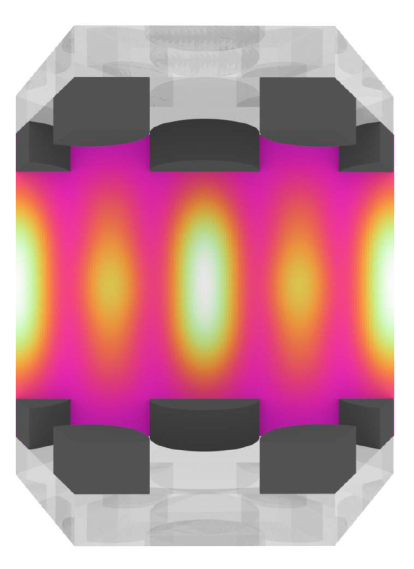Enhancing circular dichroism from chiral molecules using designed photonic materials
Measuring circular dichroism (CD) from chiral molecules is important to distinguish their handedness. This information is required, e.g. in the pharmaceutical industry, as different enantiomers can cause vastly different actions. The CD signal is derived from measuring the difference in absorption upon illuminating a sample with light of different circular polarization, i.e. helicity. As the CD signal is extremely small, it often has to be integrated over many hours to raise it notably above the noise level. This is a burden and reducing the measurement time or being able to measure within the same time analytes of lower concentrations is a prime scientific challenge.
We design and realize structured photonic materials for this purpose. The fundamental challenge is to perceive materials that do not affect the dispersive CD signal but only raise the signal level. For that, the photonic structures need to be achiral, helicity preserving, and resonant. Designing structures that meet all three requirements is a prime challenge. Structures considered so far were rather idealistic and not necessarily suitable for an experiment. In consequence, tools from the field of computational material design shall be applied to identify structures that can be realised with existing technologies and which are simultaneously insensitive against imperfections in the fabrication process.
However, the situation gets even more challenging, as the detection limits are not dictated by the photonic structures. That can be made to be achiral, helicity preserving, and resonant, but the molecules to be sensed are not. Indeed, they are necessarily chiral and mostly not helicity preserving. Therefore, in each scattering process a tiny amount of opposite helicity is generated that piles up because the light interacts many times with the molecules thanks to the cavity effect. To understand that effect requires a chemical analysis of the molecules that shall be integrated into a holistic device simulation.
The complementary aspects of optical and chemical simulations are brought together in a digital twin. The digital twin predicts the outcome of experiments to judge the suitability and to assure that the devices operate as anticipated. Its purpose is to investigate prior a experiment the impact of a modifications to (1) the experimental scheme, (2) the details of the photonic structures, and (3) the molecular material. This allows unambiguously to judge the suitability of the entire system.
| Name | Institute |
|---|---|
| Carsten Rockstuhl | Institute of Theoretical Solid State Physics (TFP) |
| Willem Klopper | Institute of Physical Chemistry (IPC) |
| Martin Wegener | Institute of Applied Physics (APH) |


